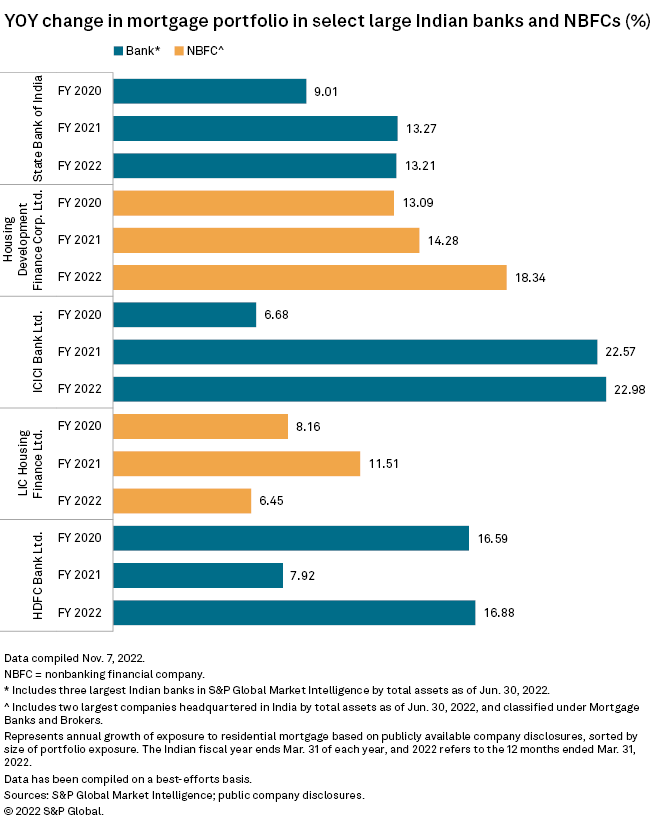S&P Global Offerings
Featured Topics
Featured Products
Events
S&P Global Offerings
Featured Topics
Featured Products
Events
S&P Global Offerings
Featured Topics
Featured Products
Events
Banking & Capital Markets
Economy & Finance
Energy Transition & Sustainability
Technology & Innovation
Podcasts & Newsletters
Banking & Capital Markets
Economy & Finance
Energy Transition & Sustainability
Technology & Innovation
Podcasts & Newsletters
S&P Global Offerings
Featured Topics
Featured Products
Events
27 Nov, 2022
By Ranina Sanglap and Marissa Ramos
Indian lenders can expect to keep the quality of their home loan books even with rising interest rates, as the nation's housing market remains in an upcycle.
Most property purchases in India include a loan, typically from a bank or a nonbanking financial company, or NBFC. Bank loans to residential real estate rose 16% year over year to 18.058
"We expect asset quality to remain broadly steady in the home loan segment," Krishnan Sitaraman, senior director and deputy chief ratings officer at CRISIL, told S&P Global Market Intelligence. "Historically, asset quality on home loans for banks and NBFCs has not weakened too much." The gross nonperforming loan ratio in the banks' home loan portfolios stood at 1.7% as of March 2022, and has generally stayed below 2.0%, Sitaraman noted.
Home sales in the six months to June rose 60% year over year to 158,705 units, according to data from Knight Frank Research. Sales in the first half of the year "have convincingly broken through and reached the highest level since the first half of 2013," the real estate consulting company's research unit reported in July.
However, since all players compete for the same customers, NBFCs have been ceding market share to banks in recent years because of their relatively higher funding costs. NBFCs had a market share of 38% in the home loan segment in 2022, down from 42% three years ago, according to a Sept. 14 report from CRISIL.

Rising rates
The RBI has been raising rates, along with most global peers, to tamp inflationary pressures. The Indian central bank has raised its benchmark overnight lending rate by a total of 190 basis points since May. With inflation easing in recent months, economists expect further rate hikes to be less steep. Still, the elevated rates have translated to higher monthly payments for most borrowers.
"I don't think interest rate hikes will have a material impact on growth for housing. A house purchase unlike other products is planned after a lot of due diligence within the family," said Renu Sud Karnad, managing director at Housing Development Finance Corp. Ltd., or HDFC, the biggest housing NBFC in the country by assets. Housing loans typically carry a floating interest rate, and unlike a car or a consumer durable loan, they are long-term, usually lasting 12 to 15 years, Karnad said, adding that interest rates have relatively less impact on borrowers' cash flows.
However, home prices in India have continued to rise. RBI's House Price Index, a weighted average of 10 city indexes, grew to 290.6 in the January-to-March quarter of 2022 from 285.5 a year ago.
"Home loans reached decadal historic lows during the pandemic, helping to kick-start a demand avalanche that hasn't slowed down even as home loan interest rates have begun creeping up," said Anuj Puri, chairman of Anarock Group, an independent real estate services company.
"The demand is not temporary investor sentiment generated by promises of returns on investment — it is genuine end-user demand driven by the Indian's hard-coded predilection towards homeownership," Puri said in comments emailed to Market Intelligence.
Housing demand could falter if there is oversupply based on developers' exaggerated demand perception or excessive speculative interest in housing, Puri said. However, "all are extremely unlikely, given learnings from the past, the new highly regulated market environment and India's continuingly conservative banking system which does not support speculative activity," Puri added.
Slowdown elsewhere
India's housing boom contrasts with several other markets, such as the U.S., China and Australia, where mortgage demand has been more sensitive to interest rates. For example, U.S. mortgage rates are now reaching 7%, up from 3.2% a year ago, according to an Oct. 5 report from Oxford Economics. Prices in each of these markets have declined.
"I expect the market to normalize from the strong rebound in the coming quarters. Affordability will become a more pertinent issue, as inflation eats away at real incomes, monetary policy continues to tighten and house prices elevate further by higher building costs," said Priyanka Kishore, head of India and Southeast Asia, macro and investor services, at Oxford Economics.
Lenders such as HDFC, however, are confident that housing demand won't abate soon. The demand for housing is structural in India, given its demographics, rapid urbanization and economic growth, said HDFC's Karnad. "I don't think we can even think about the saturation of the home loan market," the executive said.
HDFC requires the borrower to put in a reasonable amount of equity upfront while taking a loan. Its average loan-to-value at origination stood at 70% for the quarter ended Sept. 30, which gives the lender a buffer. The company's collection efficiency for individual loans on a cumulative basis was more than 99% during the quarter ended Sept. 30. HDFC's gross individual nonperforming loans at Sept.30, were 0.73% of the individual portfolio and total nonperforming loans were 1.44% of the loan portfolio.
"[The] home loan market in India is very mature and every player is very prudent while lending. As long as lending institutes are not doing anything irrational, it is a market that has immense scope to grow," Karnad said.
